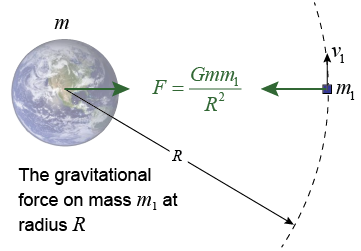|
 To determine whether the path of a moving object will be an orbit, consider a satellite of mass m1, moving with linear velocity v1, near a planet with a much larger mass m. When is the gravitational force sufficient to move the satellite in a circular orbit with radius R? To solve the problem, recall the equation for the centripetal force required to cause an object to move in a circular path of radius R.
To determine whether the path of a moving object will be an orbit, consider a satellite of mass m1, moving with linear velocity v1, near a planet with a much larger mass m. When is the gravitational force sufficient to move the satellite in a circular orbit with radius R? To solve the problem, recall the equation for the centripetal force required to cause an object to move in a circular path of radius R. 
|
To derive the orbit equation (7.6) we set the gravitational force at radius R equal to the centripetal force needed to keep a mass m1 moving in a circle. 
|

|
| (7.6) | | | R | = | orbital radius (m) | | G | = | gravitational constant | | | = | 6.67×10-11 N m2/kg2 | | m | = | mass of central object | | v | = | satellite orbital speed (m/s) |
| Orbit equation
for circular orbits |
|
The radius of a circular orbit depends on the mass of the planet divided by the square of the satellite’s velocity. The higher the velocity, the smaller the orbital radius. This is because it takes a stronger force to hold a faster moving object in a circular path, and gravitational force decreases with distance. A satellite with double the velocity will orbit at 1/4 the radius. As equation (7.6) shows, the velocity a satellite needs to maintain a particular orbit does not depend on the satellite’s mass, but only on the mass of the planet. 
|
 Calculate the orbital velocity of a 4,000 kg satellite that orbits at a radius of 42,000 km.
Calculate the orbital velocity of a 4,000 kg satellite that orbits at a radius of 42,000 km. 
|
| Asked: | orbital velocity v | | Given: | | | Relationships: | v = √Gm/R | | Solution: | v = 3,090 m/s (6,900 mph) |
|
Notice that the orbital velocity is quite high. The velocities are even greater at lower altitude orbits. The orbital velocity of the International Space Station is 7,700 m/s (27,700 mph) at an average altitude of 414 km above Earth’s surface. 
|
A satellite follows a circular orbit around Earth at a speed of 2,200 m/s. What is the radius of this orbit? Use mE = mass of Earth = 5.98×1024 kg. - 40,000,000 m
- 82,400,000 m
- 25,600,000 m
- 18,200,000 m
 |
The answer is b.
Asked: radius r of the satellite
Given: Earth mass me = 6×1024 kg, satellite velocity v = 2,200 m/s,
gravitational constant G = 6.67×10−11 N m2/kg2
Relationships: F = Gm1m2/r2, Fc = mv2/r
Solve: Set equations equal and rearrange to solve for r: 
|
| |
|

